
PELTASTIS
DEPTH: 15 - 33 m
SKILL: All
Peltastis (ex-Alsterpark); motor ship; Greek
Built: Launched 30th December 1952, completed in March 1953 Kremer Sohn, Elmshorn, Germany
Sunk: 8th January 1968 (bad weather)
Dimensions: l=60.2 m, w=8.3 m
Coordinates: 45.16333° N, 14.64417° E
Location: about 1.5 nm NW from the settlement of Šilo on the island of Krk, 50 m from the shore
Access: 2/5 access is solely by boat (the location is in a difficult to access part of the bay)
Visibility: 2/5 in summer low, in winter considerably better
Current: 4/5 mostly weak
Flora and fauna: 5/5 varied life on and around the wreck, occasionally specimens of large fish
HISTORY:
In the Kremer Sohn shipyard in northern Germany in 1953 was built a rather small cargo ship of 874 tons. It was given the name Alsterpark from the title of its parent company P/R Alsterpark from Hamburg. It was a motor ship intended for coastal navigation. In 1967 the ship changed owners. The new owner was a Greek company from Piraeus and the ship was renamed the Peltastis. However in its new owner’s hands it did not sail long. During the night of 7th - 8th January a hurricane like storm hit Kvarner. Due to the “bura” and the forecast of bad weather, Peltastis left the port of Jurjevo south of Senj in the afternoon hours of 7th January, where it had it taken on a cargo of timber, and set off towards Rijeka in the search of secure anchorage. With nightfall a blizzard began, so the ship anchored in the region of Pazduhovo near Dramlja, about 2 nautical miles north of Crikvenica. During the night the wind grew so strong that both anchors began to plough through the muddy seabed. Not even the power of the ship’s engine could help in the struggle with the wind and the waves so the ship slowly drew closer to the rocky shore of the island of Krk, between the location of Šilo and the cove of Solin (Klimno). Several crashes on the underwater rocks caused a breach in the engine room and the ship sank at 0350 hrs.
From the 12 members of the crew four were rescued. In the following days seven bodies were found, and the ship’s commander, Captain Teodoros Belesis was declared as missing. For some unknown reason an official dive was not carried out, however the visits of other “unofficial” divers began very quickly, as early as the following spring to dive on the ship. They remarked that the bridge was “cleared” of all the interesting souvenirs, and that beside the navigation table “some man” was leaning in an upright position. The dead captain in the bridge confirmed the old maritime tradition that the commander goes down together with this ship. The removal of the body was organised by the Centre for Underwater Research from Kostrena whose divers carried out the act.
WRECK CONDITION AND DIVING:
The bow of the Peltastis is turned towards the coast of the island of Krk. The top of the bow is at a depth of 15 metres, whilst the deepest part of the ship - the propeller is at a depth of 33 metres. Due to the shallow depths, the wreck of the Peltastis is ideal for all categories of divers. Although souvenir hunters have taken all the most valuable objects, the ship is exceptional because of its excellent preservation. Unlike older ships whose decks have collapsed, and whose hull sides are slowly rotting, this wreck will offer every diver the impressive sensation that he is diving on a “real” ship. All the main sections of the ship are undamaged and in situ – the masts, derricks, funnel, ventilators etc. Just by diving down the main mast, we will catch sight of the entire bow and middle part of the ship below us. Around the mast a large shoal of two-banded breams gather which, accustomed to divers, stay just out of reach. The superstructure is at the stern, and the bridge dominates it. It can be entered by the large doors on both sides of the bridge. The internal partitions between the navigational cabin and the bridge have disappeared so the space is light and spacious.
Care should be taken when entering into the ship’s narrow areas. All these areas are partially filled with fine silt which can be stirred up with the slightest of wave of fins, and which can reduce visibility to just a few centimetres. For the same reason it is especially dangerous to go into the engine room. Not so long ago one careless diver perished who without special preparations entered this dark place from which he never found his way out. Therefore it is best to keep to the outer sections of the ship.
The propeller and rudder are half-buried in the sand. On the left side of the stern we come across a long recess with a large hole, where the sharp rocks ruptured the ship’s hull. The ship’s masts are overgrown with thick layers of crustaceans and algae. At the top of the mast two-banded breams follow us as we leave sometimes almost swimming to the surface.
Visibility on the ship is not the best, due to the current in the Velebit Channel which causes the sediment to stir up. Visibility does not generally exceed ten metres, but occasionally the visibility does increase to 20-30 metres, and then we can experience the ship much more. Therefore diving on the Peltastis can often be a surprise and a special challenge.
In the Kvarner Bay area there are several wrecks, however due to its attractiveness, accessibility and rich flora and fauna, the wreck of the motor ship Peltastis finds itself on the top of the list of destinations on the eastern coast of the Adriatic.
The description and illustrations are a courtesy of Danijel Frka and Jasen Mesić. Buy the whole book here: https://shop.naklada-val.hr/product_info.php?products_id=561
Built: Launched 30th December 1952, completed in March 1953 Kremer Sohn, Elmshorn, Germany
Sunk: 8th January 1968 (bad weather)
Dimensions: l=60.2 m, w=8.3 m
Coordinates: 45.16333° N, 14.64417° E
Location: about 1.5 nm NW from the settlement of Šilo on the island of Krk, 50 m from the shore
Access: 2/5 access is solely by boat (the location is in a difficult to access part of the bay)
Visibility: 2/5 in summer low, in winter considerably better
Current: 4/5 mostly weak
Flora and fauna: 5/5 varied life on and around the wreck, occasionally specimens of large fish
HISTORY:
In the Kremer Sohn shipyard in northern Germany in 1953 was built a rather small cargo ship of 874 tons. It was given the name Alsterpark from the title of its parent company P/R Alsterpark from Hamburg. It was a motor ship intended for coastal navigation. In 1967 the ship changed owners. The new owner was a Greek company from Piraeus and the ship was renamed the Peltastis. However in its new owner’s hands it did not sail long. During the night of 7th - 8th January a hurricane like storm hit Kvarner. Due to the “bura” and the forecast of bad weather, Peltastis left the port of Jurjevo south of Senj in the afternoon hours of 7th January, where it had it taken on a cargo of timber, and set off towards Rijeka in the search of secure anchorage. With nightfall a blizzard began, so the ship anchored in the region of Pazduhovo near Dramlja, about 2 nautical miles north of Crikvenica. During the night the wind grew so strong that both anchors began to plough through the muddy seabed. Not even the power of the ship’s engine could help in the struggle with the wind and the waves so the ship slowly drew closer to the rocky shore of the island of Krk, between the location of Šilo and the cove of Solin (Klimno). Several crashes on the underwater rocks caused a breach in the engine room and the ship sank at 0350 hrs.
From the 12 members of the crew four were rescued. In the following days seven bodies were found, and the ship’s commander, Captain Teodoros Belesis was declared as missing. For some unknown reason an official dive was not carried out, however the visits of other “unofficial” divers began very quickly, as early as the following spring to dive on the ship. They remarked that the bridge was “cleared” of all the interesting souvenirs, and that beside the navigation table “some man” was leaning in an upright position. The dead captain in the bridge confirmed the old maritime tradition that the commander goes down together with this ship. The removal of the body was organised by the Centre for Underwater Research from Kostrena whose divers carried out the act.
WRECK CONDITION AND DIVING:
The bow of the Peltastis is turned towards the coast of the island of Krk. The top of the bow is at a depth of 15 metres, whilst the deepest part of the ship - the propeller is at a depth of 33 metres. Due to the shallow depths, the wreck of the Peltastis is ideal for all categories of divers. Although souvenir hunters have taken all the most valuable objects, the ship is exceptional because of its excellent preservation. Unlike older ships whose decks have collapsed, and whose hull sides are slowly rotting, this wreck will offer every diver the impressive sensation that he is diving on a “real” ship. All the main sections of the ship are undamaged and in situ – the masts, derricks, funnel, ventilators etc. Just by diving down the main mast, we will catch sight of the entire bow and middle part of the ship below us. Around the mast a large shoal of two-banded breams gather which, accustomed to divers, stay just out of reach. The superstructure is at the stern, and the bridge dominates it. It can be entered by the large doors on both sides of the bridge. The internal partitions between the navigational cabin and the bridge have disappeared so the space is light and spacious.
Care should be taken when entering into the ship’s narrow areas. All these areas are partially filled with fine silt which can be stirred up with the slightest of wave of fins, and which can reduce visibility to just a few centimetres. For the same reason it is especially dangerous to go into the engine room. Not so long ago one careless diver perished who without special preparations entered this dark place from which he never found his way out. Therefore it is best to keep to the outer sections of the ship.
The propeller and rudder are half-buried in the sand. On the left side of the stern we come across a long recess with a large hole, where the sharp rocks ruptured the ship’s hull. The ship’s masts are overgrown with thick layers of crustaceans and algae. At the top of the mast two-banded breams follow us as we leave sometimes almost swimming to the surface.
Visibility on the ship is not the best, due to the current in the Velebit Channel which causes the sediment to stir up. Visibility does not generally exceed ten metres, but occasionally the visibility does increase to 20-30 metres, and then we can experience the ship much more. Therefore diving on the Peltastis can often be a surprise and a special challenge.
In the Kvarner Bay area there are several wrecks, however due to its attractiveness, accessibility and rich flora and fauna, the wreck of the motor ship Peltastis finds itself on the top of the list of destinations on the eastern coast of the Adriatic.
The description and illustrations are a courtesy of Danijel Frka and Jasen Mesić. Buy the whole book here: https://shop.naklada-val.hr/product_info.php?products_id=561

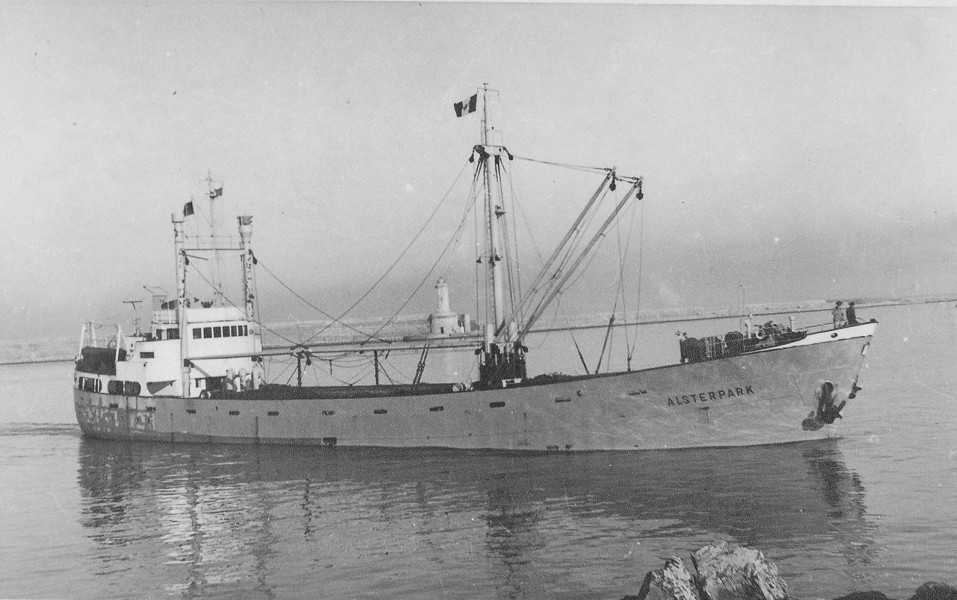
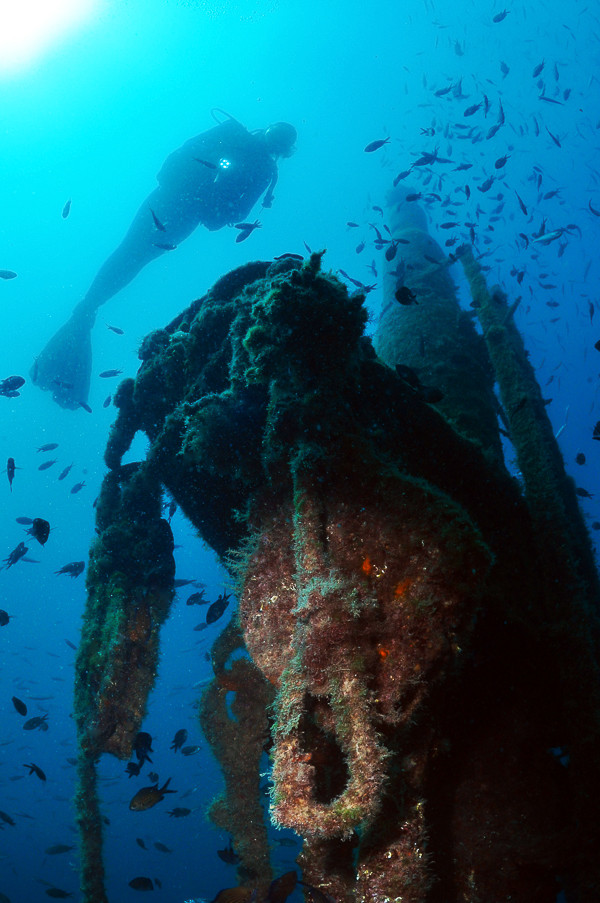
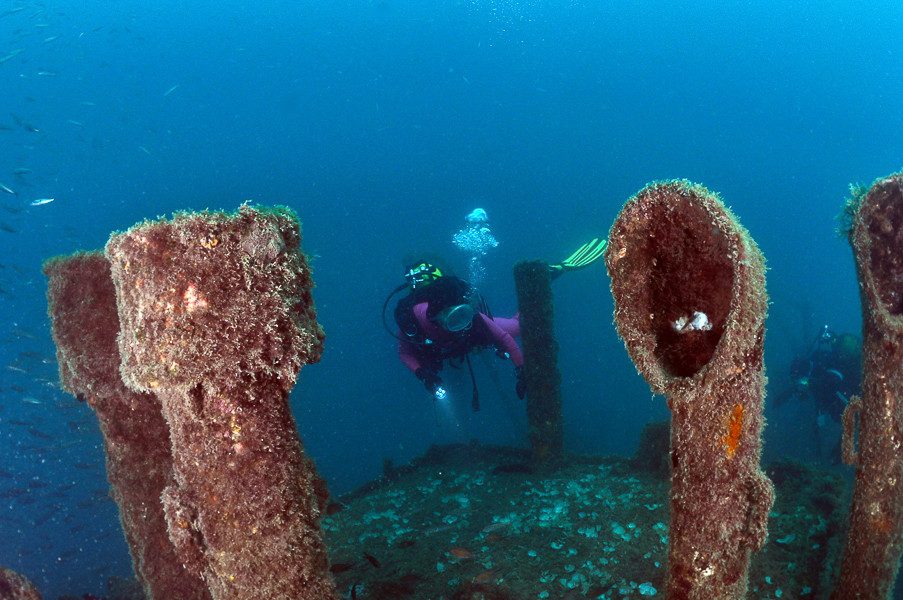
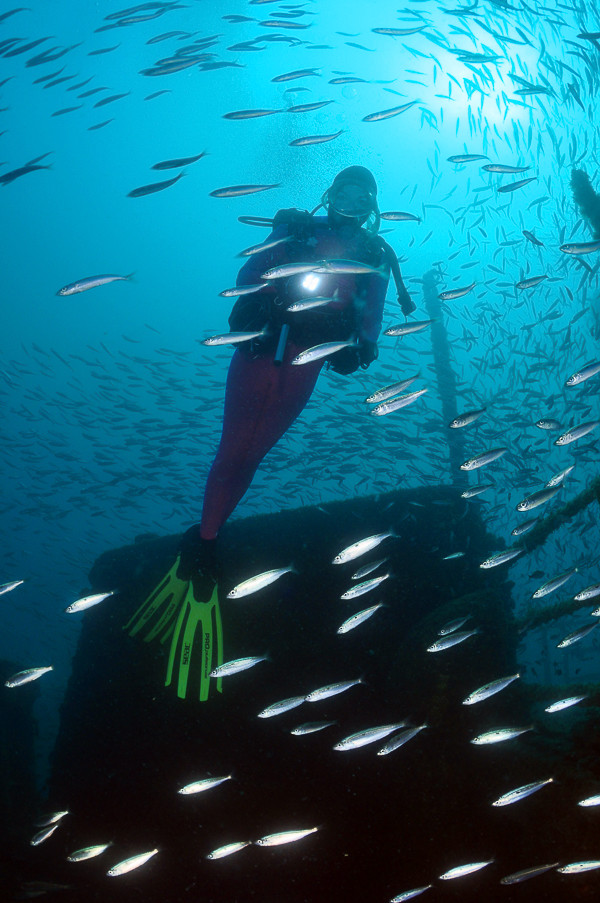
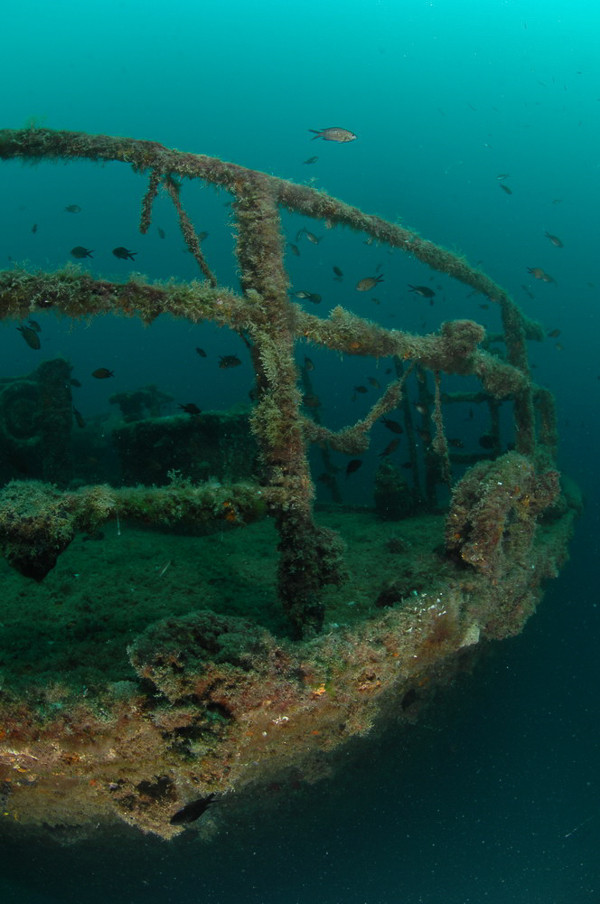
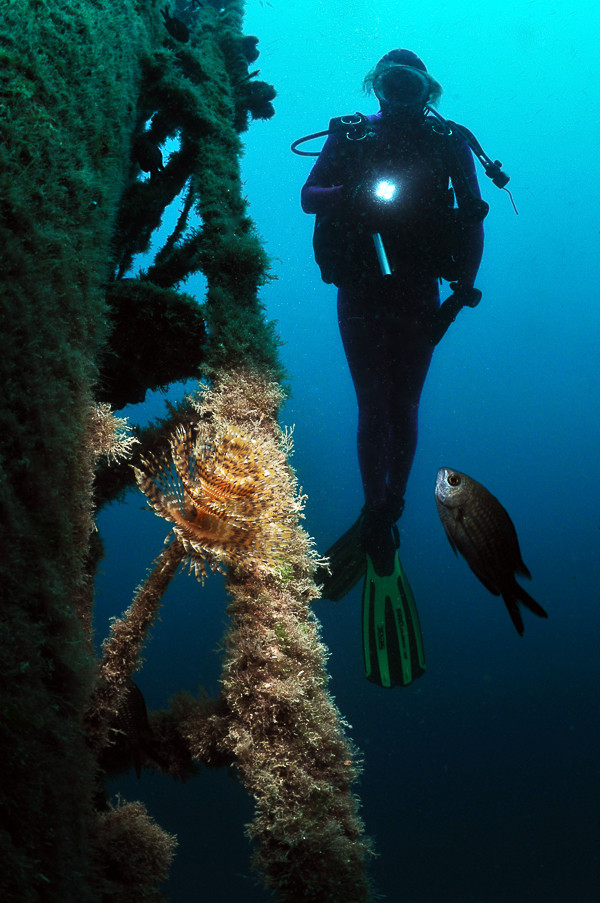
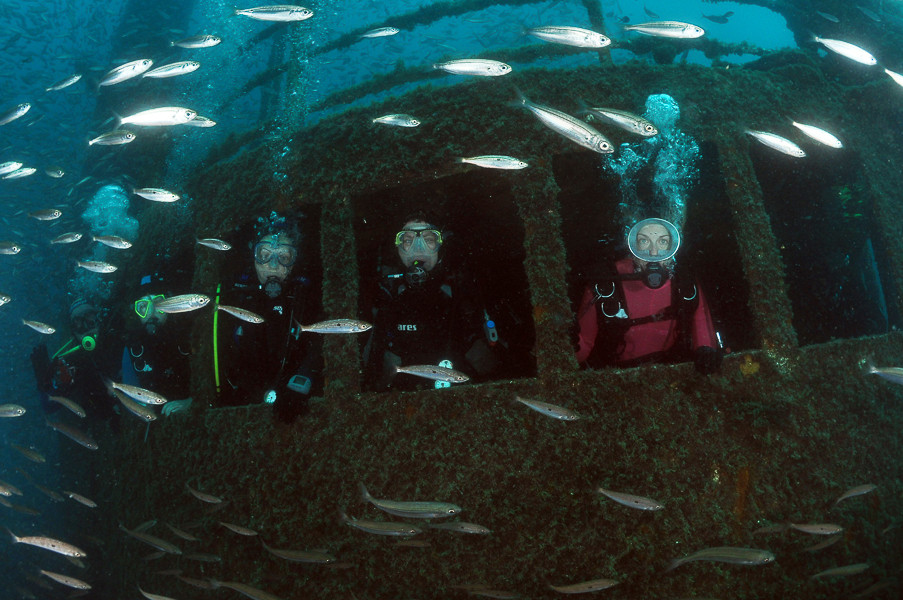
 The investment is co-financed by the Republic of Slovenia and the European Union from the European Regional Development Fund.
The investment is co-financed by the Republic of Slovenia and the European Union from the European Regional Development Fund.  H2O Globe BETA
H2O Globe BETA